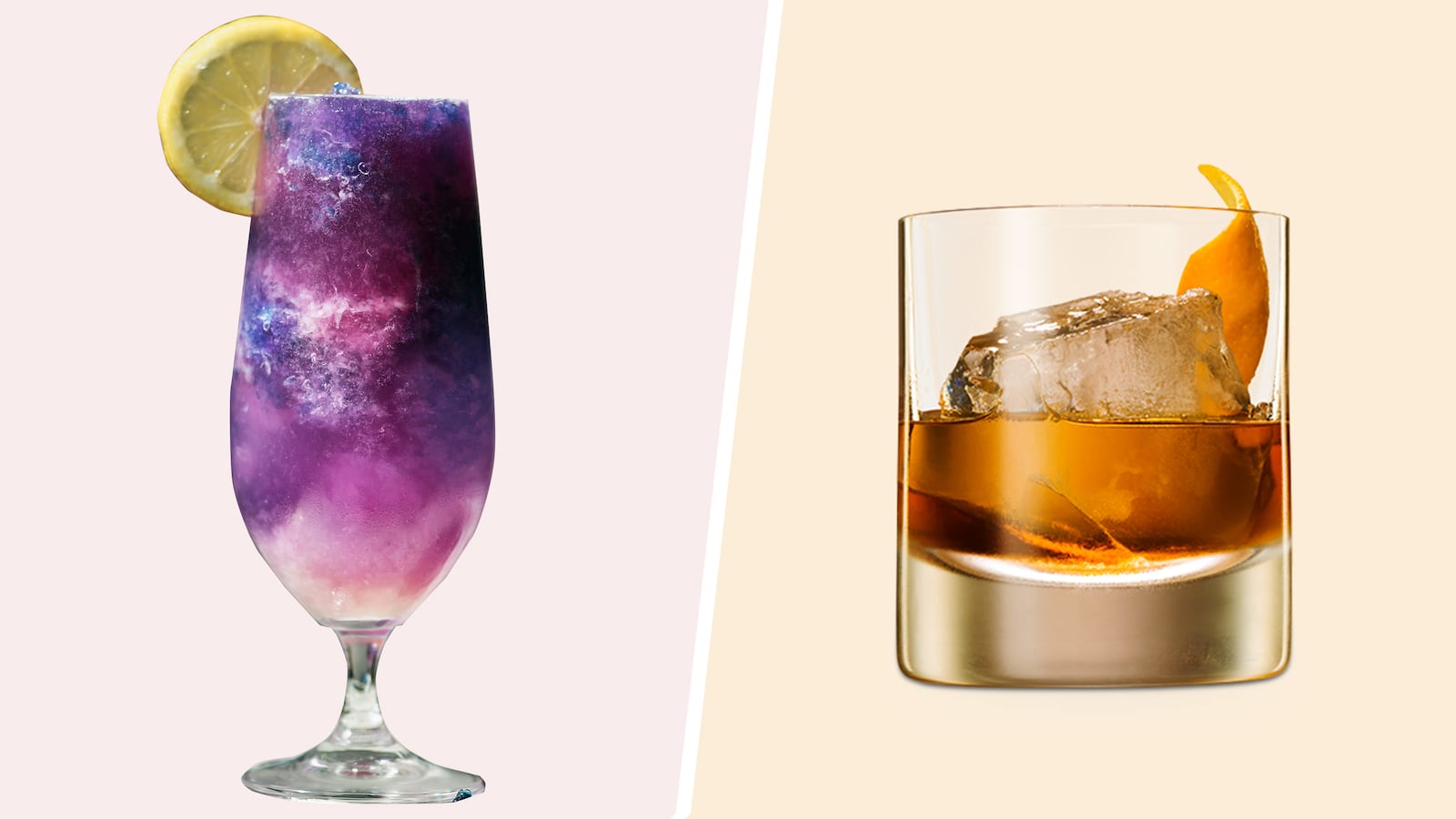Let’s talk about cocktail menus. You know, the thing they hand you in every modern cocktail lounge and hipster restaurant with a couple of classic cocktails nestled among a whole passel of new drinks you’ve never come across before and neither has anyone who hasn’t bellied up to that bar in the last month or two. The names will be inscrutable—“Della Valle’s Larkin”—and the ingredients will include things like “hedge mucklethorn,” “kleiner pickelhaube” and “retro-acidulated bamboo milk;” things you’ve never heard of and couldn’t possibly predict the flavor of.
Even the couple of familiar classics on there are, on closer examination, not what they seem. They’re Pet-Sematary versions of the drinks you know. They’ve been to the burying ground and they’ve come back, and they’re changed. That Manhattan that you knew as straight rye, Italian vermouth and Angostura Bitters is now laver-infused Falls of the Gowanus oat whiskey, vintage Votrix vermouth and Amaro Cavaradossi; the Daiquiri is clear and white as rubbing alcohol; the Sidecar has quince and Escubac in it.
For some people, all of this is great—it’s why they’re there. New means different and different is good (and Instagrammably different is even better). I’m not here to dispute what gives people sincere pleasure and, indeed, I used to be among that crowd. But after two decades as a drink writer I’m finding that a great many of the cocktails that broadcast their wild originality taste surprisingly like everything else that’s out there (and if they don’t, often enough they probably should).
It could be the result of a jaded palate, but I’ve been sipping spirits professionally just as long as I have been cocktails and my palate still lights up from new and exotic types of booze (Mexican charanda, I’m looking at you). Rather, I suspect there’s a Law of Cocktails at work here, one that says that the more ingredients you put into a drink the less unique it is likely to taste (see the whole universe of tiki drinks, which despite their many disparate ingredients have a strong tendency to revert to rummy Hawaiian Punch).
Fortunately, some bars are starting to say enough is enough. When, in the next few weeks, St. John Frizell opens Gage & Tollner, his resurrection of the landmarked 1892 Brooklyn institution that closed in 2004, his cocktail list will be classics only, and real ones, not the undead versions more common today. A couple of other bars have opened recently around the country with the same idea, bars by experienced operators like Frizell.
I’m not saying that classics-only is right for every bar, but the current model isn’t right for every bar either. In fact, historically speaking, the idea that all your drinks should be unique to your bar is an anomaly.
The drinks menu, as an institution, is surprisingly old. At the end of 1842, Peter Bent Brigham opened a renovated and expanded version of his oyster saloon on Court Street in Boston. Along with the fancy décor, one of the things he offered was a printed list of 18 drinks. This was such a novelty that it got a lot of press. By October, 1843, Brigham had blown it up to 49 drinks and it was being reprinted widely in newspapers and magazines.
More importantly, Brigham’s list was also being copied, pretty much verbatim, by saloons all over America and as far afield as Paris. Some eventually added a few drinks of their own, but many stuck quite close to the list. Even John Hammack, who offered 83 different drinks at the saloon he opened in 1861 at Pennsylvania Avenue and 15th Street in Washington, D.C., didn’t stray all that far from Brigham’s list once you account for the drinks that were just minor variations on Brigham’s.
By the 1870s, though, Brigham’s list had begun to seem pretty long in the tooth, and the 1880s brought in a new consensus about what a bar should offer. With surprisingly minor changes this pretty much held through the 1960s, both in America and internationally. Sure, there were changes. Egg drinks dropped out by 1900 and you began to find citrus juice in cocktails. There were more cocktails in general, and fewer Juleps and Sangarees. The Bronx, the Daiquiri, the Singapore Sling, the Sidecar, the Bloody Mary, the Moscow Mule and the Margarita made it onto the list. Scotch whisky and dry gin came along in the 1890s, Bacardi Rum in the 1900s, vodka and tequila in the 1930s and 1940s. Meanwhile, Dutch genever, New England rum and applejack fell out of use.
But over those eight decades, a great many things remained constant, at least as long as you stayed out of tiki bars (although after an initial spurt of wild creativity in the 1930s even those menus, colorful as they might be, all tended to offer pretty much the same drinks, too). The middle lozenge of the Venn diagram between what was on most cocktail bars’ lists in the two or three decades before Prohibition and what was on there in the 1960s was wide and comfortable. Take, for example, the list of cocktails the Detroit Athletic Club offered in 1916, with its 31 drinks. Even though it offered more originals than most—by my count, ten, including the mighty Last Word—it still had 21 canonical ones. In 1962, Toronto’s Silver Rail bar had 20 cocktails on its list; 12 of them were also on the Athletic Club’s list, including exactly what you’d expect: the Martini, the Manhattan, the Old-Fashioned, the Daiquiri (or Bacardi Cocktail, as it was also known), and a few others we don’t see quite as often these days but probably should, including the Alexander, the Stinger, the Dubonnet and the Rob Roy.
The basic list only changed in the 1970s when the Baby Boomers invited a new canon of drinks to sweep in like Genghis Khan and his Golden Horde, slashing and burning and driving all before them. In the early 2000s, that new canon, with its Long Island Iced Teas and its Harvey Wallbangers, its Mudslides and its Amaretto Sours and its Kamikaze-led army of shooters, began to get pushed out in turn by the old gang, back from exile and ready to fight. The old drinks were successful, to be sure—the Old-Fashioned is probably the defining drink of the 2010s—but they didn’t have things all their way. The 1970s it’s-your-thing-do-what-you-wanna-do idea of mixology proved very hard to kill and eventually a compromise was reached. What that played out as in most cocktail bars is drinks that look classic and use classic, or classic-inspired, techniques and ingredients, but wave their hands up in the air shouting “hey lookit me I’m different” like so many Red-Headed Sluts and Adios Motherfuckers.
When you bring up the idea of going back to the basic list with bartenders and bar owners, there are a couple of common objections. The first is more from the owners, and it’s basically, “if I do this how will I be able to distinguish my bar from other bars.” Clearly, there are other ways, since for almost a hundred years bars didn’t use the uniqueness of their drinks to create that differentiation. Rather than putting their energy into that, they had to stoop to using things like careful execution (including well-chosen ingredients and finely-calibrated proportions), hospitality, service, friendliness, ambience, and music. The things that are, OK, only the main reasons that all but a tiny number of geeks go to bars in the first place.
Bartenders’ objections are a little more personal: “won’t I get bored?” and, more importantly, “how will I get ahead if I can’t use my cocktails to build a reputation?” If Duncan Nicol of the Bank Exchange in San Francisco, who spent his days happily making one Pisco Punch after another, each precisely assembled to the same stringent specifications, were here, he would laugh. The bartender’s job offers a great many things more amusing than sifting ingredients together like some low-grade research chemist.
Besides, giving up the Pet-Sematary way with the classics doesn’t mean you have to veer off into the Stepford Wives way. There’s a great deal of creativity and art involved in making any traditional recipe shine. Just ask an Italian chef or a barbecue pitmaster. What’s more, a list that’s mostly classics still offers a couple of slots for new drinks, and with a far better chance that they’ll get noticed and catch on. A good many of today’s blue-sky mixology drinks are truly excellent, as delicious as they are innovative. But the way things stand now they’re often lost among the near misses, far misses, and what-the-fuck-were-you-even-thinkings. And then, three or four months later, they’re gone, because it’s time for our all-new spring menu.
If the Margarita had been buried among ten or fifteen other innovative new drinks when John Durlesser started serving it at the Tail o’ the Cock in Los Angeles, back in 1952 or 1953, odds are it wouldn’t have started selling so much that the Cuervo distributor had to stop in to see what the hell the bar was doing to move more tequila than all of his other accounts put together. Then it wouldn’t have made it into a national ad campaign, and—who knows—there’s a chance it might have missed its moment entirely, and we’d all be tailgating these days with Pisco Sours or Caipirinhas or some other exotic drink.
Better for bartender and drinker both if all that creative energy is fed into coming up with one or two well-tested, keenly-honed, delicious drinks than 18 almost-there ones.
Getting beyond the objections, finally, there’s what the bar gains. If it’s in a restaurant, it’s going to sell a lot more cocktails, because it’s going to have a lot fewer confused, intimidated, even frustrated customers who came in for the food and would like something nice to whet their appetites but have no idea what the hell sweet-potato juice is doing in a cocktail and don’t care that the vinegar-prickly pear shrub is house-made. Modern restaurants that want to stay in business make sure they have a burger and a roast chicken on their menu. Many modern cocktail menus don’t offer that equivalent. Those who would like such a thing might default easily enough to a glass of wine or a beer, but they’re not getting what they want and the restaurant is already in the hole before they’ve even ordered their meal. Sure, with today’s better-trained bartenders, if there’s a classic they want they can order it off-menu and probably get a good one, but that forces people to think of a drink, make sure they’ve got it right, hope that calling it forth from memory doesn’t make them look like a lush to their acquaintances, and generally do all the mental work. That’s not very hospitable.
For straight cocktail bars, taking stunt mixology off the table offers bartenders an opportunity to talk with their customers about more important things than infusion times or amaro botanicals and hopefully, in the process turn sensation-seekers into regulars. Regulars keep bars open. It’s worth a try, anyway, and I really hope more new bars will do that.

